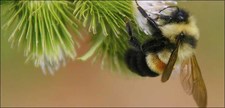Please the Bees!: Teaching Students About Pollinators
Have you heard the buzz? On March 21, 2017, the rusty patched bumble bee was listed as an endangered species, marking the first time ever that a bee has been put on the Endangered Species List. The rusty patched bumble bee joins the likes of 700 other plants and animals listed as endangered in the United States. Their declines have a lot to do with what is occurring in Iowa and other Upper Midwestern states.
A Common Trend for Pollinators
Rusty patched bumble bees, named for the rust-colored spot on the back of the insect, are native to the grasslands and tallgrass prairies of the Midwest and East Coast (pictured at right, courtesy of Dan Mullen). Twenty years ago, this bumble bee could be found in 28 states. Today, its population has decreased by 87%, and is found in only 13 states in the United States. One of those states is Iowa.
The rusty patched bumble bee represents a larger trend affecting pollinators of all types: habitat loss. Much of the habitat that pollinators rely upon has been lost due to the conversion of prairies and grasslands into agricultural and developed areas. Disease, pesticides, climate change and lack of food availability can also contribute to loss of pollinators. Habitat loss in Iowa is putting stress on pollinators. The good news is that you can be a part of the solution right in your own backyard or classroom!
Connecting Students to Nature with Citizen Science
Educators across Iowa utilize creative methods to get kids thinking about pollinators and habitat loss. Pollinators like monarch butterflies make long migration journeys each year and rely on suitable habitat for each step of their journey. Laura Lake, a teacher for more than 20 years at Glidden-Ralston Community School District in west central Iowa, incorporates a citizen science website called Journey North into her Title 1 reading lessons to teach students in Grades K-6 about monarch butterflies. Journey North allows users to report sightings of monarch butterflies, and then uses the reports to map monarch migration in real time.
“We have used this website extensively to learn facts, read migration maps, read the latest migration news and view photos,” Laura said. “My students have especially enjoyed reading about the life cycle, looking at charts and photos to identify growth stages of both the butterfly and the milkweed plants and tracking the fall and spring migrations on the maps.”
To give students a hands-on experience with monarch growth cycles, Laura also brought real monarch eggs and caterpillars into the classroom. During an exciting schoolwide event, her students released the butterflies.
“When the butterflies were ready to fly, we released them during recess so many of the children were able to cheer them on their way to Mexico!” Laura said. Learning about monarch butterfly migration left students anticipating the return of the monarchs to Iowa each year. Laura’s students have also participated in the Symbolic Migration, which connects students in the U.S. and Canada with students who live near the monarchs’ winter habitat in the mountains of Mexico.
Pollinator School Gardens
Alice Fuglsang, a 7th grade science teacher at Indian Hills Junior High in West Des Moines, used the Plant.Grow.Fly program, part of the Blank Park Zoo in Des Moines, to jump-start a pollinator lesson for her students. In her lesson, students were tasked with designing a pollinator garden for their school. With a series of four sketches, students had to consider how they could attract native pollinators using both host and nectar plants. Gardens had to include a nesting area where pollinators could lay their eggs with a food and water source nearby for the offspring. Native plant species were also encouraged in the design. To tie each garden element back to pollinators, “Students had to give a reason for why they were including each thing,” Alice explained. “It was neat to see how their sketches changed throughout the project.”
By designing a pollinator garden, students learned about plant cellular processes, types of plants, plant structure, ecological organization, populations, symbiotic relationships among living things and adaptations for survival. Students presented their final projects to Iowa State University Reiman Gardens Butterfly Wing employees, Nathan Brockman and Anita Westphal.
Through their design alterations and sketching, “They realized the need for this type of garden in our community,” Alice commented. Once the pollinator garden is constructed on school grounds, Alice plans to use the same design concept for future years and have kids design pollinator gardens for their backyards.
For more information about pollinator gardens and starting a school garden, go to the Blank Park Zoo's webpage for the Plant.Grow.Fly program.


